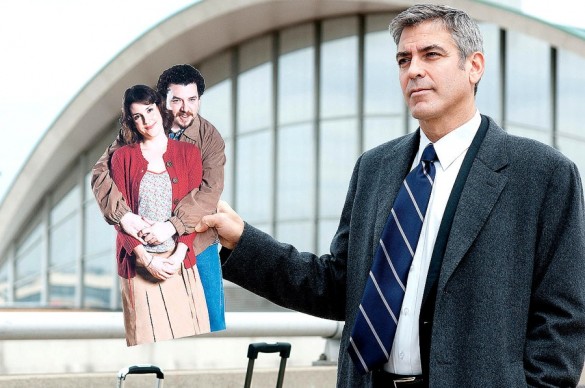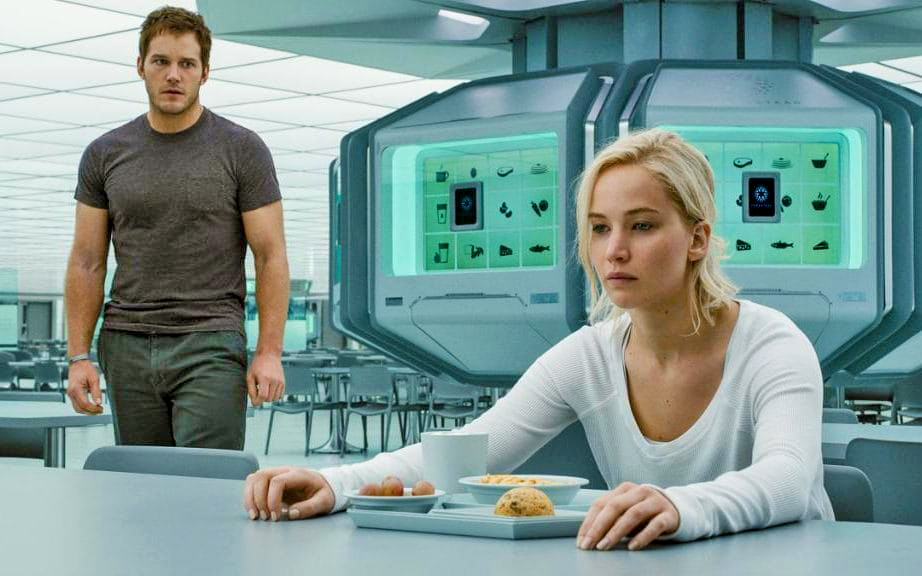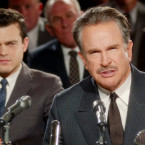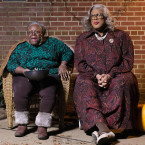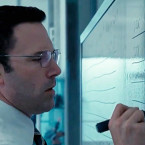News & Notes Inside the Week in Film
Reluctantly Crouched at the Starting Line, Movies are Now Going the Distance
The stories are everywhere: Oscar nominated movies are longer now than ever before… Except for the part where they aren’t. The 2013 Oscar Season myth busting continues.
 by Chris Neumer
by Chris Neumer
Of late, journalists everywhere have been tripping over themselves to discuss the (apparently) big issue in Hollywood: how the big movies of the year (read: Best Picture nominees) are longer than ever. Some find it weird that with everything now more condensed, films are getting longer; some find it unusual that with Americans’ attention spans getting shorter, running times are higher than they’ve ever been; some arrive at their numbers by incredibly faulty math and sheer omission (I checked the math they did and they are off by as much as seven minutes in some cases); some are just arguing that movies now are too long, while others point out that while they have no idea whether films actually are getting longer, they certainly feel like they’re getting longer.
Sigh.
Lost in all the caterwauling about the nearly three-hour running times of Zero Dark Thirty, Lincoln, The Life of Pi, The Hobbit*, Django Unchained and Les Miserables and the definitely longer than two hour running times of Argo, Amour and Silver Linings Playbook is some historical perspective. Namely: movies nominated for Oscar today might well be long—Zero Dark Thirty’s 157 running time is a lengthy piece of cinema no matter when it was released—but their length is actually shorter than average for Best Picture nominees since 1990.
* Of the movies mentioned here, The Hobbit is the only one not to have received a Best Picture Oscar nomination.
As I poured over the slew of news stories and columns about how long movies were getting, one thing stood out to me: no one ever mentioned any contextual numbers. Oh sure, it was loudly trumpeted that you could cook and carve a turkey dinner in a shorter amount of time than it took to watch Les Miserables, but almost no one ever compared the current crop of movies to past crops. (I saw two articles where the writers did this and both were fraught with problems; one cited a ‘study’ that an imdb user had done, the other used extremely faulty math).
So I started checking into this. I had my assistant look up all the running times of movies nominated for Best Picture since 1990 and quickly learned the reason that no one cites any numbers in their movies-nominated-for-best-picture-are-getting-longer articles: because movies nominated for Best Picture are absolutely, positively, categorically not getting longer.
The lowest average running time of the Best Picture nominees since 1990 occurred in 2011, with a time of 1:51:30. The second lowest average running time came in 1990 with 1:55:24. The third lowest came in 2010, with 1:59:30. 2012 and 2006 then tied for the fourth lowest average running time with 2:00:36. 2008 and 2007 then placed sixth and seventh with 2:02:48 and 2:06:12 respectively.
In chronological list form, here are the years that the average length of the films nominated for Best Picture ran under 130 minutes:
1990
1997
2006
2007
2008
2010
2011
2012
And here are the years that the average length of the films nominated for Best Picture ran over 140 minutes:
1991
1994
1999
2002
2003
2004
From this, it’s hard to make any kind of an argument that the movies nominated for Best Picture are getting longer. These numbers actually prove the opposite: films nominated for Best Picture are getting shorter. Looking at the average running times of the films nominated for Best Picture in five-year increments, it’s even easier to see that these movies are truly decreasing in length:
1990-1994 2:15:06
1995-1999 2:14:42
2000-2004 2:19:06
2005-2009 2:07:36
2010-present 2:01:30
So, about that whole Best Picture nominees are getting longer thing… yeah… maybe we should stop talking about that…
Running (Out of) Time
Several interesting tidbits of information about the Best Picture nominees’ running times.
by Chris Neumer
One of the most interesting year-to-year changes came from 1990-1991. 1990 featured the second shortest average running time amongst films nominated for Best Picture. Field of Dreams, Dead Poets Society, My Left Foot, Born on the Fourth of July and the winner, Driving Miss Daisy averaged about 115 minutes apiece. 1991 featured the longest average running time amongst Best Picture nominees. Ghost, Goodfellas, Awakenings, The Godfather: Part III and winner Dances with Wolves averaged about 148 minutes apiece.
The three longest films to have been nominated for Best Picture since 1990 are 1) JFK (206 minutes), 2) The Lord of the Rings: Return of the King (200 minutes), and 3) Titanic and Schindler’s List (196 minutes each).
The three shortest films to have been nominated for Best Picture since 1990 are 1) Beauty and the Beast (84 minutes), 2) Midnight in Paris (88 minutes) and 3) Good Night and Good Luck (90 minutes).
Interestingly, while none of the three shortest films won Best Picture, three of the four longest films did win; Return of the King, Titanic and Schindler’s List.
Life Imitates Art… God Dammit
Director Steven Soderbergh’s film Contagion was based on a hypothetical situation. Emphasis on ‘was’.
by Chris Neumer
In 2011, Steven Soderbergh directed a modern day disaster film called Contagion. It was somewhat ramshackle, Traffic like examination of the outbreak of a deadly new disease with no known cure. The movie is not recognized as one of Soderbergh’s best, mainly due to the fact that several of its plot lines felt very thin; while Traffic had a running time of 147 minutes, Contagion had only 106 and a lot was lost with the shorter running time.
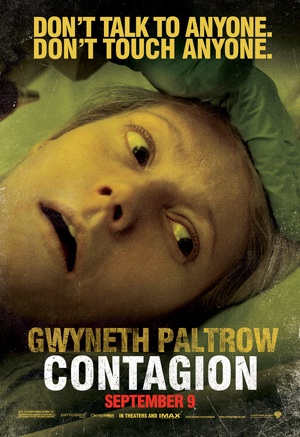 The film does quite ably display Soderbergh’s hyper realistic examination of topics though. And in this case, it was to his extreme credit that he managed to make scenes of people grabbing handrails on the subway, opening doors at a grocery store or pushing into a bathroom horrifyingly scary; this is the way that the germs are passed along!
The film does quite ably display Soderbergh’s hyper realistic examination of topics though. And in this case, it was to his extreme credit that he managed to make scenes of people grabbing handrails on the subway, opening doors at a grocery store or pushing into a bathroom horrifyingly scary; this is the way that the germs are passed along!
When Contagion was released, most people felt it was a sensationalistic examination of what would happen if the swine flu mutated. There was some eye-rolling at the Hollywood fear tactics and contented sighs from audiences members when they realized that Contagion was purely fiction.
Or, at least, it was when Contagion was released in September of 2011.
Last week, the Japan Times reported that a new virus, Severe Fever with Thrombocytopenia Syndrome (SFTS), with what the Center for Disease Control calls a “high-case fatality rate”, claimed its first Japanese victim. The Japan Times reported that the virus, much like the disease in Contagion, is “characterized by symptoms such as nausea… a fall in appetite and headaches. [It] can be transmitted through contact with a victim’s blood and bodily fluids.” Oh, and there’s no cure or vaccine for the disease.
Originally, the infection was found in rural China. Several farmers contracted SFTS from tick bites. What makes the first Japanese victim for SFTS such a scary proposition is twofold: 1) he had no “trace of a mite bite” on him, nor had he done any traveling, and 2) the virus that killed him was not genetically comparable to the Chinese version of SFTS.
Why is it when life imitates art, it never does so by developing flubber or having ten-year old boys pitch for the Chicago Cubs?
The Photo of the Week
George Clooney inUp in the Air
When I first saw this photo from Up in the Air, I just assumed that a couple had Photoshopped themselves into the picture. Then when I looked more closely, I saw it was Danny McBride and the actress who played Marcy on The Shield. I don’t know what to say; I know it’s real, but it still looks supremely fake.
The 5 Things I Learned This Week
Fascinatingly true things to broaden your mind
1) The Chinese version of Twitter is called Sina.
2) Mexico not only has a Navy, but after a second fatal shark attack in Mexican waters, the Navy took out after the sharks to apparently deal out some justice Chief Brody style.
3) Tuaregs refer to the northern part of Mali as Azawad.
4) Angelina Jolie is my own age, 37. It only feels like she’s much younger.
5) When oil was first discovered in the United States in the early 1860’s, the part of the country known as the “Oil Region” was northwestern Pennsylvania.
This Week’s Stories
- Best Picture Nominees Are, In Fact, Getting Shorter
- Interesting Information on the Running Times of the Nominees
- Going Viral: Life Imitates Contagion
- New Releases
- The Photo of the Week
- Trivial Fascinations: The Five Things I Learned This Week
New Releases
Anna Karenina
 THE PLAYERS: Starring Kiera Knightley, Jude Law, and Aaron Taylor-Johnson; written by Tom Stoppard; directed by Joe Wright; Released by Focus. Rated R.
THE PLAYERS: Starring Kiera Knightley, Jude Law, and Aaron Taylor-Johnson; written by Tom Stoppard; directed by Joe Wright; Released by Focus. Rated R.
THE PLOT: Anna Karenina (Knightley), a Russian aristocrat, engages in an affair with a powerful count.
THE SKINNY:
– It always throws me off when Hollywood adapts foreign works of literature, sets them in foreign lands, plans on producing them in foreign lands and then casts British actors in them. In this regard, Enemy at the Gates is probably the worst offender in history (see article to left).
+ Actor Aaron Taylor-Johnson is the closest thing we have to the next Johnny Depp. Right now, Taylor-Johnson is in the pre-Edward Scissorhands stage of his career. Just wait, in 15 years, Taylor-Johnson will be headlining the reboot of Pirates of the Caribbean, people will be talking about how great he is and I’ll be losing my mind yelling about how I saw this coming in 2013.
– That said,
+ It’s in the Hollywood bylaws: every fifteen years or so, somebody needs to release another interpretation of Anna Karenina. There was one in 1997, 1985, 1976, 1967, 1948 and 1935. We won’t need to worry ourselves with another installment until sometime in approximately 2030.
+ Keira Knightley is devilishly charming and positively delightful in the lead here.
– This version of Anna Karenina takes some liberties with the original source material and tends to feel a tad hollow and empty as a result.
YES, IT’S TRUE: Leo Tolstoy and his wife, Sophia Andreevna Behrs had thirteen children.
Argo
 THE PLAYERS: Starring Ben Affleck, Bryan Cranston, and John Goodman; written by Chris Terrio; directed by Ben Affleck. Released by Warner Bros. Rated R.
THE PLAYERS: Starring Ben Affleck, Bryan Cranston, and John Goodman; written by Chris Terrio; directed by Ben Affleck. Released by Warner Bros. Rated R.
THE PLOT: American and Canadian secret service agents plot to free and bring home several diplomats being held in Iran.
THE SKINNY:
+ Words cannot expression the entertainment value in knowing that Ben Affleck has now played a Hispanic character.
+ Argo is a very taut thriller about an ultimate situation that doesn’t seem as though it would generate any kind of edge-of-your-seat excitement.
+ Ben Affleck’s direction is truly superb. The irony of this is, of course, that he did not get nominated for an Academy Award for Best Director.
– Despite the based-on-a-true-story nature of the project, Argo does fall prey to some of the most tried-and-true Hollywood conventions at the worst possible times. As the hostages are attempting to leave Iran, the driver of the van they’re in can’t get the van into gear. I saw this and sighed. It’s not enough that hordes of kill-happy Revolutionary Guards are chasing after you, but you also have to include the bus driver not being able to get the bus in gear? I guess on the plus side, the bus did start up right away.
+ Alan Arkin and John Goodman are laugh out loud funny in their supporting roles…
– …unfortunately, if you give the characters any thought at all, it quickly become apparent that there is absolutely no need to have included them in the movie, except for, you know, their ability to make funny quips about the state of Hollywood.
YES, IT’S TRUE: In Greek mythology, Argo is the ship that Jason and the Argonauts sailed on to obtain the golden fleece.
The Factory
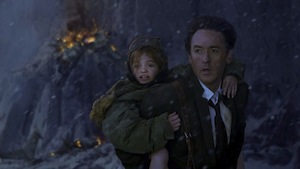 THE PLAYERS: Starring John Cusack, Dallas Roberts, and Vincent Messina; written by Morgan O’Neill and Paul Leyden; directed by Morgan O’Neill. Released by Warner Bros. Rated R.
THE PLAYERS: Starring John Cusack, Dallas Roberts, and Vincent Messina; written by Morgan O’Neill and Paul Leyden; directed by Morgan O’Neill. Released by Warner Bros. Rated R.
THE PLOT: A detective chases the serial killer who has kidnapped his daughter.
THE SKINNY:
– John Cusack is sharing above-the-title credit with… Jennifer Carpenter? To put this in perspective, Carpenter doesn’t even get above-the-title credit on the TV show that she stars in with Michael C. Hall, Dexter. Who the hell gets headlining status on their side project?
– This feels like a bad episode of Without a Trace, except without the character development.
+ Set in Buffalo, New York (shot in Montreal, Quebec), The Factory takes place during winter. The snow and near constant snowfall on screen is a very nice change of pace.
– The plot of this film revolves around the fact that Cusack is racing against the clock to save his kidnapped daughter. Ignore, for the time being, that police departments generally don’t allow family members to investigate crimes against their own flesh and blood, and focus on this: the reason that the good, loving father’s daughter was kidnapped was because the serial killer thought she was a prostitute. Somebody screwed up somewhere along the line…
– Um, Cusack signed on to do this movie in late 2007, more than a year before President Obama was elected to office. The Factory started shooting in January of 2008… and was released to theaters almost five years later. Five years!!! Enough said.
YES, IT’S TRUE: 88% of serial killers are male, and 85% are caucasian.
Sinister
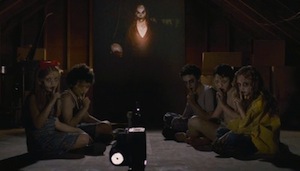 THE PLAYERS: Starring Ethan Hawke, Juliet Rylance, and James Rasone; written by Scott Derrickson and C. Robert Cargill; directed by Scott Derrickson. Released by Warner Bros. Rated R.
THE PLAYERS: Starring Ethan Hawke, Juliet Rylance, and James Rasone; written by Scott Derrickson and C. Robert Cargill; directed by Scott Derrickson. Released by Warner Bros. Rated R.
THE PLOT: A writer’s family faces untold horror after he finds a box of films depicting murders committed by the killer he is currently researching.
THE SKINNY:
– Yes, nighttime is scarier than daytime, but the fact that everything in this movie appears to be lit with a single light bulb from far away—if lit at all—grows old very quickly.
– It may be silly to mock the premise of a horror movie, but it needs to be done here: a true crime author decides to move his family into the house of the murdered family that he is researching. Really? No, uh, second thoughts about this one? Spoiler alert: he probably should have had some.
+ Sinister has helped me realize that when I move into the house of a family that was brutally murdered and find a box of old 8MM reels in the attic that I will not watch them, lest I accidentally start a chain of events that will end… (ominous pause) in death!!!!!!
+ Sinister has a number of interesting scares and twists throughout its running time.
– However, it also has a lot of the standard horror movie clichés in it. Your friends will probably recommend the movie to you with a liberal dose of the word ‘actually’; “I actually saw Sinister recently and it was actually pretty good.” If anyone ever tries to set me up for a date by using the word ‘actually’ while talking about me, I’m going to be very pissed off.
+ The fact that the budget for this movie was $3 million and it starred Ethan Hawke should prompt a fair amount of discussion around the proverbial table. How is it possible that Hawke doesn’t make that much per movie? More to the point, in this situation, it seems like Hawke might have gotten about $1 million for his work here.
YES, IT’S TRUE: Ethan Hawke published a novel in 1996 called The Hottest State.
The New Releases were written by Chris Neumer and Kevin Withers
Columns |
Columns |
Columns |
Columns |
Columns |
Columns |
Columns |
Columns |
Columns |
Columns |
Columns |
Columns |
